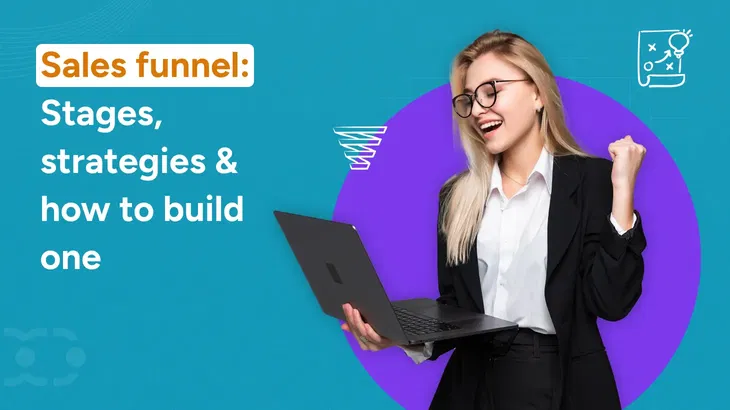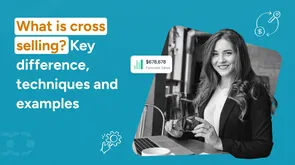Did you know? Nearly 79% of marketing leads never turn into paying customers.
One major reason?
Many businesses lack a structured sales funnel that effectively guides leads toward a purchase.
A sales funnel model acts as a roadmap, ensuring that leads don't just enter your business ecosystem but move toward conversion through structured touchpoints and nurturing strategies.
In this guide, we'll cover:
- The key stages of a high-converting sales funnel
- How to build a sales funnel that brings conversions
- Actionable strategies to improve conversions at every step
Let's dive in!
What is a sales funnel?
Think of a sales funnel as a guided customer journey.
Just like a funnel directs liquid into a container without spilling, a well-designed sales funnel guides potential customers step-by-step toward purchasing, minimizing lost opportunities.
At the top, you attract a large audience. As they move through the funnel, some lose interest, while others engage deeper, eventually converting into customers.
The goal of a sales funnel is to guide and optimize this journey, ensuring that as many qualified leads as possible reach the final stage, the purchase.
How a sales funnel increases revenue and prevents lead leakage?
Without a structured funnel, businesses often face lost opportunities and a lack of clarity in their s sales model.company'
On average, businesses that implement structured sales funnels see conversion rates of 5.31%, more than double the industry average of 2.35%.
Here's why having a sales funnel is important for every business:
1. Boosts revenue potential
A well-defined sales funnel strategy ensures that every website visitor and inquiry is systematically guided through the buying journey, reducing lead drop-offs and increasing conversions.
With this structured approach, businesses can convert more leads and create a steady revenue stream.
2. Prevents missed opportunities
Without a funnel, leads often fall through the cracks due to disorganized follow-ups or lack of nurturing.
A sales funnel ensures every potential customer gets the right attention, reducing lost sales and increasing conversions.
3. Accelerates the sales process
Buyers don't always make instant decisions, so the sales funnel helps by removing friction and providing the right information at the right time.
Automation (emails, product demos, follow-ups) shortens the buying journey.
Beyond preventing lost opportunities, a well-structured funnel actively speeds up conversions by delivering timely engagement.
4. Maximizes marketing ROI
Since sales funnels nurture leads through automation, businesses spend less time acquiring new customers and more time converting high-intent prospects.
Hence, automated lead nurturing can result in lower CAC (Customer Acquisition Cost) and higher ROI.
5. Increases customer lifetime value
Businesses that focus on existing customers generate up to 95% of their revenue from renewals and upsells, proving that retention is as critical as acquisition.
A funnel keeps customers engaged through personalized recommendations, loyalty programs, and follow-up offers, leading to higher retention and repeat sales.
6. Supports business scalability
Businesses can handle ten times more leads by automating repetitive sales tasks without increasing their sales team size, making growth more efficient and cost-effective.
Stages of a sales funnel (Explained with examples)
Every successful sales funnel begins with awareness, where businesses attract potential customers.
Each stage guides leads from initial engagement to conversion, ensuring prospects remain engaged throughout the journey.
Let's explore the four essential sales funnel stages:
1. Awareness: Attracting potential customers
The top of the sales funnel is where potential buyers first become aware of a business, often without realizing they have a problem that needs solving.
Brands must create content that helps prospects recognize their pain points before presenting solutions.
The goal is to get on their radar through various marketing channels, such as content marketing, SEO, social media, and digital ads.
Businesses must capture attention without immediately pushing for a sale. Instead, they should provide valuable, informative content that subtly introduces their brand.
For instance, an awareness stage tactic could be:
A CRM software company publishes a blog post titled "10 Signs Your Sales Team Needs a Better CRM". To encourage engagement, they offer a free checklist in exchange for an email, effectively capturing leads without a direct sales pitch.
2. Interest: Educating and nurturing leads
The next step is education and trust-building now that prospects know your brand. Leads in this stage are actively exploring solutions but are not yet ready to buy.
Leads that are nurtured well make purchases that are 47% larger than non-nurtured leads.
Businesses should focus on delivering value through educational content like case studies, free resources, and expert insights.
Here's an example for you for better clarity:
A marketing agency offers a free eBook titled "How to Automate Your Email Campaigns." Once downloaded, the lead enters a strategic email sequence, receiving insights, success stories, and actionable steps that gradually prepare them for a buying decision.
The only guide you need: Lead nurturing guide: Key strategies for boosting sales
3. Decision: Overcoming objections and closing deals
The decision stage is when buyers ask: Is this the right solution for me?
At this point, they are actively evaluating options but may hesitate due to concerns about pricing, ROI, or implementation challenges.
Addressing these doubts with compelling evidence, such as testimonials and free trials, can significantly improve conversions.
Businesses should remove doubts by offering risk-free options such as free trials, discounts, testimonials, or one-on-one consultations.
The example below will be insightful for learning the tactics of the decision stage:
A B2B SaaS company offers a 7-day free trial of its software. To maximize conversions, it sends follow-up emails reminding users of the trial's expiration and highlighting how the software has helped similar businesses.
Additionally, a sales rep reaches out to high-intent leads to address any final concerns.
4. Action: Converting and retaining customers
The customer journey isn't the end, but the real growth comes from retention and repeat business.
After a purchase, businesses must focus on follow-ups, upsells, loyalty programs, and onboarding (SaaS business tactic) to keep customers engaged and drive repeat sales.
Research found that 70% to 95% of business revenue using upsells and renewals comes from existing customers.
A sales funnel alone isn't enough—it needs to be supported by a structured sales pipeline that ensures leads are managed effectively at each stage. Continue with sales pipeline vs sales funnel.
So, a well-structured sales funnel process combined with an efficient sales pipeline guarantees that every lead is strategically guided toward conversion.
Build targeted buyer personas!
Understand, segment, and engage your ideal customers with Salesmate's free template.
Moving on to understand how to create a sales funnel.
How to build a high-converting sales funnel (step-by-step guide)
If your website gets plenty of traffic but not enough conversions, you're likely missing key elements in your sales funnel process.
Let's review the key sales funnel steps to build a high-converting funnel that turns visitors into paying customers.
1. Define your ideal customer
Your sales funnel is only as strong as your understanding of your target audience. Trying to appeal to everyone results in low conversions and wasted marketing efforts.
So, instead of a one-size-fits-all approach, segment your audience and tailor your messaging accordingly.
You can begin by sorting your leads into three groups:
- Cold leads – Unaware of your solution but may have a problem you can solve.
- Warm leads – Exploring different solutions but undecided.
- Hot leads – Ready to take action but may need a final push.
Tip: If unsure of what drives conversions, analyze existing customers. What persuaded them to buy? Reverse-engineering their journey can help refine your sales funnel process.
2. Create high-value lead-generation assets
People won't enter your sales funnel unless they see an immediate value exchange.
So, offer compelling, irresistible lead magnets that encourage engagement and drive sign-ups.
What works best?
- Educational blog posts, videos, and LinkedIn articles: Instead of selling, provide real solutions.
- Tools, templates, and cheat sheets: For instance, a one-page 'Sales Funnel Optimization Checklist' performs better than a lengthy eBook because it provides immediate value without overwhelming the reader.
- SEO & paid ads: If your target audience can't find you, they won't enter your funnel. Optimize content for search visibility and use retargeting ads.
A sales funnel template is one of the best resources for streamlining your process. This template provides a clear roadmap for effectively structuring lead capture, nurturing, and conversions.
3. Set up an automated lead capture & follow-up system
Capturing leads is just the first step—most will disengage without an effective follow-up system.
Use automation to engage leads quickly and ensure they don't slip through the cracks.
Key elements of a lead capture system:
4. Nurture leads without being pushy
Most prospects won't buy immediately, and that's okay. Your job is to stay relevant and top-of-mind until they're ready.
Offer value-first communication that subtly moves leads toward conversion.
Here are some of the best nurturing tactics:
- Personalized email sequences: Share insights, useful content, and success stories instead of sales-heavy pitches.
- Retargeting ads: It can bring back visitors who left your site without taking action and increase conversion rates by up to 147%.
- Social proof & case studies: Real-world examples build trust faster than sales pages alone.
Insightful read: 15 Best follow-up email templates [With best examples]
5. Optimize your conversion process
Even when leads are ready to buy, they might hesitate due to friction. So, eliminate barriers that slow down conversions.
Here's how to improve conversions:
- Simplify checkout & sign-ups: Fewer steps, clear pricing, and seamless payment options.
- Reduce decision paralysis: Offer risk-free trials or money-back guarantees to remove doubts.
- Create urgency (the right way): Limited-time offers work only if they feel genuine.
6. Automate, analyze, and refine
A high-converting sales funnel is never "finished." The best businesses continuously optimize for better performance.
So, your approach should be to identify where leads drop off and why—then fix it.
Here are some proven ways to optimize:
- Automate follow-ups: Invest in the best CRM to streamline lead nurturing.
- A/B test offers and messaging: What works today might not work tomorrow.
- Analyze drop-off points: Find where leads are getting stuck and optimize those touchpoints.
Want a sales funnel that works on autopilot?
Invest in automation and analytics tools to track, improve, and scale your results.
Sales funnel examples: B2B vs. B2C breakdown
Sales funnels follow the same core structure, but B2B and B2C businesses execute them differently.
B2B funnels rely on trust-building, long sales cycles, and multi-stakeholder approvals, while B2C funnels prioritize speed, convenience, and impulse-driven decisions.
On the other hand, B2C customers make buying decisions faster when they experience seamless, personalized engagement.
Let's explore how these well-known brands, LinkedIn Sales Navigator (B2B) and Netflix (B2C), structure their funnels for maximum conversions.
1. B2B sales funnel example: LinkedIn Sales Navigator
LinkedIn Sales Navigator, a B2B sales intelligence tool, targets sales teams seeking prospecting and lead generation solutions.
Since B2B purchases require justification and multiple approvals, LinkedIn structures its funnel around education, lead nurturing, and social proof.
It starts with awareness. We use targeted ads, industry reports, and thought leadership content to attract sales professionals.
At the interest stage, LinkedIn offers free guides, case studies, and gated reports in exchange for emails, generating high-quality leads.
Once engaged, prospects enter the decision phase, where LinkedIn provides free trials and demo calls to showcase its value.
Finally, LinkedIn encourages long-term commitment in the action stage through limited-time offers and enterprise-tier features.
This structured funnel works for LinkedIn because B2B buyers conduct extensive research before committing.
B2C sales funnel example: Netflix
Netflix's B2C sales funnel focuses on quick adoption, frictionless onboarding, and long-term retention.
Unlike B2B buyers, B2C customers don't require extensive research. A PwC study found that 73% of consumers say experience is the primary factor influencing their purchasing decisions.
Netflix creates awareness through digital ads, influencer collaborations, and social media engagement, driving curiosity.
The platform streamlines the interest stage with free trials or discounted first-month offers, reducing hesitation.
At the decision stage, Netflix's AI-driven content recommendations personalize the experience, increasing engagement.
Finally, in the action phase, Netflix retains users through reminder emails, retargeting, and exclusive previews, reinforcing habit formation.
This funnel is effective for Netflix because B2C purchases are largely emotion-driven.
Notes that understanding the B2C and B2B sales funnel stages can help businesses create a structured path that moves prospects from awareness to decision-making efficiently.
Insightful read: Developing an automated sales funnel for a revenue boost.
How do you optimize the sales funnel to maximize conversions?
By now, you understand the importance of a well-structured sales funnel that systematically guides leads from awareness to conversion.
But what separates high-performing funnels from the rest isn't just a well-defined process. It's the ability to optimize at scale, refine based on data, and eliminate friction proactively.
This section goes beyond basic funnel structuring and explores advanced strategies for maximizing conversions, improving efficiency, and increasing customer lifetime value.
1. Segment users by behavior for personalized experiences
Segmenting users based on behavior, intent, and past interactions allows for more tailored communication that directly addresses their needs.
For instance, if a user downloads a lead magnet but doesn't engage further, an automated email sequence can nurture them with additional insights. Meanwhile, high-intent leads—such as those who visit the pricing page multiple times—can be offered a free consultation.
Real-time behavioral tracking further refines segmentation, ensuring hyper-relevant messaging that drives faster conversions.
2. Incorporate interactive content to boost engagement
Interactive elements like quizzes, ROI calculators, and product recommendation tools encourage users to engage actively, keeping them invested in your brand while qualifying them for more targeted follow-ups.
For instance, we have run a quiz titled "Find the Best CRM for Your Business." This engages users and segments them according to their needs, enabling our sales teams to customize their outreach effectively.
Users who engage with interactive content are more likely to convert as they experience direct value before purchasing.
3. Use predictive analytics to prevent drop-offs before they happen
Predictive analytics identifies at-risk leads before they disengage.
AI tools analyze browsing behavior to detect hesitation points, such as prolonged time spent on pricing pages. This allows businesses to intervene with targeted messaging or incentives before prospects abandon their purchases.
Businesses can automate interventions by tracking behaviors such as prolonged time on pricing pages, multiple visits without action, repeated cart abandonment, etc.
The automated interactions could be based on chat support triggers, personalized email follow-ups, or limited-time offers.
Insightful read: 21 AI sales tools to boost sales in 2025 [Reviewed & tested]
4. Trigger exit-intent pop-ups to capture abandoning users
Exit-intent pop-ups help re-engage users at the last moment, offering incentives that encourage action.
For B2B businesses, this could be a free whitepaper or an exclusive webinar invite, reinforcing your brand's authority. For eCommerce, it might be free shipping or a limited-time discount to reduce purchase hesitation.
Pairing exit-intent pop-ups with retargeting ads further increases effectiveness. If a user leaves the site but later sees a retargeted ad with a personalized offer, they are more likely to return and complete their purchase.
5. Streamline mobile checkout to reduce friction and cart abandonment
A slow mobile checkout experience leads to a 35% drop in conversions. Simplifying checkout reduces frustration and prevents last-minute drop-offs.
A smooth checkout experience is critical to reducing friction and increasing conversion rates.
- Reduce form fields: only ask for essential details to prevent drop-offs.
- Enable guest checkout: forcing account creation often discourages buyers.
- Offer one-click payments: Apple Pay, Google Pay, and saved payment methods streamline the process.
- Display trust signals: badges, refund policies, and real-time purchase notifications build confidence at the final stage.
For SaaS businesses, making onboarding effortless—with self-serve setup guides or extending a free trial—can convert hesitant users into paying customers. A well-optimized checkout experience ensures that leads don't lose momentum at the last step.
6. Audit your sales funnel regularly to fix weak points
Regular audits and optimizations prevent weak points from impacting revenue.
To ensure consistent improvements:
- A/B test landing pages, CTAs, and email sequences.
- Use heatmaps and session recordings to track where users drop off.
- Apply cohort analysis to understand how different audience segments engage with your funnel over time.
Even minor changes—such as tweaking CTA wording or simplifying a pricing page—can significantly improve conversions.
Businesses that consistently perform a sales funnel analysis to track drop-off points, optimize conversion paths, and test engagement strategies maintain a competitive edge and drive higher ROI.
Looking for a CRM to boost sales conversions?
Automate, track, and optimize your funnel with Salesmate CRM to close more deals and maximize revenue.
Final thoughts
The best sales funnel differentiates scattered marketing efforts from a predictable, scalable revenue model.
Businesses that consistently refine their funnels see higher conversion rates, reduced customer acquisition costs, and stronger customer relationships.
Start optimizing your sales funnel today with Salesmate CRM.
Automate lead tracking, personalize customer journeys, and convert more leads with data-driven insights.
Frequently asked questions
1. What is the purpose of a sales funnel?
The main goal of creating a sales funnel is to guide prospective customers through a structured journey, from awareness to conversion. Delivering the right message at each stage helps businesses nurture leads, improve engagement, and increase conversions.
2. What is a sales funnel in marketing?
While many businesses focus solely on the sales funnel, sales and marketing funnels must work together. A marketing funnel attracts and nurtures leads, while the sales funnel ensures a smooth conversion process through trust-building and targeted engagement.
3. Can small businesses benefit from a sales funnel?
Absolutely! Building a sales funnel is helpful for small businesses to:
- Streamline the sales process without requiring a large sales team.
- Reduce lead leakage through automated follow-ups and nurturing.
- Increase revenue by improving lead-to-customer conversion rates.
4. How do I track the performance of my sales funnel?
Here are the most relevant sales funnel metrics to track:
- Conversion rate – Percentage of leads converting into paying customers.
- Lead-to-sale ratio – Number of qualified leads successfully converted.
- Customer Acquisition Cost (CAC) – Cost to acquire a new customer.
- Sales cycle length – Time from initial contact to deal closure.
- Drop-off rates – Identify where leads disengage from the funnel.
5. Do I need a CRM to build a sales funnel?
A CRM (Customer Relationship Management) tool is not required but significantly improves sales funnel efficiency by:
- Automating lead tracking and follow-ups.
- Personalizing customer interactions to increase engagement.
- Providing data-driven insights to optimize conversion strategies.
6. What does a sales funnel for SaaS look like?
A sales funnel for SaaS businesses typically includes a free trial or demo at the decision stage to reduce hesitation. Unlike traditional funnels, SaaS funnels emphasize long-term retention through customer onboarding, upsells, and subscription renewals.







Key takeaways
Did you know? Nearly 79% of marketing leads never turn into paying customers.
One major reason?
Many businesses lack a structured sales funnel that effectively guides leads toward a purchase.
A sales funnel model acts as a roadmap, ensuring that leads don't just enter your business ecosystem but move toward conversion through structured touchpoints and nurturing strategies.
In this guide, we'll cover:
Let's dive in!
What is a sales funnel?
Think of a sales funnel as a guided customer journey.
Just like a funnel directs liquid into a container without spilling, a well-designed sales funnel guides potential customers step-by-step toward purchasing, minimizing lost opportunities.
At the top, you attract a large audience. As they move through the funnel, some lose interest, while others engage deeper, eventually converting into customers.
The goal of a sales funnel is to guide and optimize this journey, ensuring that as many qualified leads as possible reach the final stage, the purchase.
How a sales funnel increases revenue and prevents lead leakage?
Without a structured funnel, businesses often face lost opportunities and a lack of clarity in their s sales model.company'
On average, businesses that implement structured sales funnels see conversion rates of 5.31%, more than double the industry average of 2.35%.
Here's why having a sales funnel is important for every business:
1. Boosts revenue potential
A well-defined sales funnel strategy ensures that every website visitor and inquiry is systematically guided through the buying journey, reducing lead drop-offs and increasing conversions.
With this structured approach, businesses can convert more leads and create a steady revenue stream.
2. Prevents missed opportunities
Without a funnel, leads often fall through the cracks due to disorganized follow-ups or lack of nurturing.
A sales funnel ensures every potential customer gets the right attention, reducing lost sales and increasing conversions.
3. Accelerates the sales process
Buyers don't always make instant decisions, so the sales funnel helps by removing friction and providing the right information at the right time.
Automation (emails, product demos, follow-ups) shortens the buying journey.
Beyond preventing lost opportunities, a well-structured funnel actively speeds up conversions by delivering timely engagement.
4. Maximizes marketing ROI
Since sales funnels nurture leads through automation, businesses spend less time acquiring new customers and more time converting high-intent prospects.
Hence, automated lead nurturing can result in lower CAC (Customer Acquisition Cost) and higher ROI.
5. Increases customer lifetime value
Businesses that focus on existing customers generate up to 95% of their revenue from renewals and upsells, proving that retention is as critical as acquisition.
A funnel keeps customers engaged through personalized recommendations, loyalty programs, and follow-up offers, leading to higher retention and repeat sales.
6. Supports business scalability
Businesses can handle ten times more leads by automating repetitive sales tasks without increasing their sales team size, making growth more efficient and cost-effective.
Stages of a sales funnel (Explained with examples)
Every successful sales funnel begins with awareness, where businesses attract potential customers.
Each stage guides leads from initial engagement to conversion, ensuring prospects remain engaged throughout the journey.
Let's explore the four essential sales funnel stages:
1. Awareness: Attracting potential customers
The top of the sales funnel is where potential buyers first become aware of a business, often without realizing they have a problem that needs solving.
Brands must create content that helps prospects recognize their pain points before presenting solutions.
The goal is to get on their radar through various marketing channels, such as content marketing, SEO, social media, and digital ads.
Businesses must capture attention without immediately pushing for a sale. Instead, they should provide valuable, informative content that subtly introduces their brand.
For instance, an awareness stage tactic could be:
A CRM software company publishes a blog post titled "10 Signs Your Sales Team Needs a Better CRM". To encourage engagement, they offer a free checklist in exchange for an email, effectively capturing leads without a direct sales pitch.
2. Interest: Educating and nurturing leads
The next step is education and trust-building now that prospects know your brand. Leads in this stage are actively exploring solutions but are not yet ready to buy.
Leads that are nurtured well make purchases that are 47% larger than non-nurtured leads.
Businesses should focus on delivering value through educational content like case studies, free resources, and expert insights.
Here's an example for you for better clarity:
A marketing agency offers a free eBook titled "How to Automate Your Email Campaigns." Once downloaded, the lead enters a strategic email sequence, receiving insights, success stories, and actionable steps that gradually prepare them for a buying decision.
3. Decision: Overcoming objections and closing deals
The decision stage is when buyers ask: Is this the right solution for me?
At this point, they are actively evaluating options but may hesitate due to concerns about pricing, ROI, or implementation challenges.
Addressing these doubts with compelling evidence, such as testimonials and free trials, can significantly improve conversions.
Businesses should remove doubts by offering risk-free options such as free trials, discounts, testimonials, or one-on-one consultations.
The example below will be insightful for learning the tactics of the decision stage:
A B2B SaaS company offers a 7-day free trial of its software. To maximize conversions, it sends follow-up emails reminding users of the trial's expiration and highlighting how the software has helped similar businesses.
Additionally, a sales rep reaches out to high-intent leads to address any final concerns.
4. Action: Converting and retaining customers
The customer journey isn't the end, but the real growth comes from retention and repeat business.
After a purchase, businesses must focus on follow-ups, upsells, loyalty programs, and onboarding (SaaS business tactic) to keep customers engaged and drive repeat sales.
Research found that 70% to 95% of business revenue using upsells and renewals comes from existing customers.
A sales funnel alone isn't enough—it needs to be supported by a structured sales pipeline that ensures leads are managed effectively at each stage. Continue with sales pipeline vs sales funnel.
So, a well-structured sales funnel process combined with an efficient sales pipeline guarantees that every lead is strategically guided toward conversion.
Build targeted buyer personas!
Understand, segment, and engage your ideal customers with Salesmate's free template.
Moving on to understand how to create a sales funnel.
How to build a high-converting sales funnel (step-by-step guide)
If your website gets plenty of traffic but not enough conversions, you're likely missing key elements in your sales funnel process.
Let's review the key sales funnel steps to build a high-converting funnel that turns visitors into paying customers.
1. Define your ideal customer
Your sales funnel is only as strong as your understanding of your target audience. Trying to appeal to everyone results in low conversions and wasted marketing efforts.
So, instead of a one-size-fits-all approach, segment your audience and tailor your messaging accordingly.
You can begin by sorting your leads into three groups:
2. Create high-value lead-generation assets
People won't enter your sales funnel unless they see an immediate value exchange.
So, offer compelling, irresistible lead magnets that encourage engagement and drive sign-ups.
What works best?
A sales funnel template is one of the best resources for streamlining your process. This template provides a clear roadmap for effectively structuring lead capture, nurturing, and conversions.
3. Set up an automated lead capture & follow-up system
Capturing leads is just the first step—most will disengage without an effective follow-up system.
Use automation to engage leads quickly and ensure they don't slip through the cracks.
Key elements of a lead capture system:
4. Nurture leads without being pushy
Most prospects won't buy immediately, and that's okay. Your job is to stay relevant and top-of-mind until they're ready.
Offer value-first communication that subtly moves leads toward conversion.
Here are some of the best nurturing tactics:
5. Optimize your conversion process
Even when leads are ready to buy, they might hesitate due to friction. So, eliminate barriers that slow down conversions.
Here's how to improve conversions:
6. Automate, analyze, and refine
A high-converting sales funnel is never "finished." The best businesses continuously optimize for better performance.
So, your approach should be to identify where leads drop off and why—then fix it.
Here are some proven ways to optimize:
Want a sales funnel that works on autopilot?
Invest in automation and analytics tools to track, improve, and scale your results.
Sales funnel examples: B2B vs. B2C breakdown
Sales funnels follow the same core structure, but B2B and B2C businesses execute them differently.
B2B funnels rely on trust-building, long sales cycles, and multi-stakeholder approvals, while B2C funnels prioritize speed, convenience, and impulse-driven decisions.
On the other hand, B2C customers make buying decisions faster when they experience seamless, personalized engagement.
Let's explore how these well-known brands, LinkedIn Sales Navigator (B2B) and Netflix (B2C), structure their funnels for maximum conversions.
1. B2B sales funnel example: LinkedIn Sales Navigator
LinkedIn Sales Navigator, a B2B sales intelligence tool, targets sales teams seeking prospecting and lead generation solutions.
Since B2B purchases require justification and multiple approvals, LinkedIn structures its funnel around education, lead nurturing, and social proof.
It starts with awareness. We use targeted ads, industry reports, and thought leadership content to attract sales professionals.
At the interest stage, LinkedIn offers free guides, case studies, and gated reports in exchange for emails, generating high-quality leads.
Once engaged, prospects enter the decision phase, where LinkedIn provides free trials and demo calls to showcase its value.
Finally, LinkedIn encourages long-term commitment in the action stage through limited-time offers and enterprise-tier features.
This structured funnel works for LinkedIn because B2B buyers conduct extensive research before committing.
B2C sales funnel example: Netflix
Netflix's B2C sales funnel focuses on quick adoption, frictionless onboarding, and long-term retention.
Unlike B2B buyers, B2C customers don't require extensive research. A PwC study found that 73% of consumers say experience is the primary factor influencing their purchasing decisions.
Netflix creates awareness through digital ads, influencer collaborations, and social media engagement, driving curiosity.
The platform streamlines the interest stage with free trials or discounted first-month offers, reducing hesitation.
At the decision stage, Netflix's AI-driven content recommendations personalize the experience, increasing engagement.
Finally, in the action phase, Netflix retains users through reminder emails, retargeting, and exclusive previews, reinforcing habit formation.
This funnel is effective for Netflix because B2C purchases are largely emotion-driven.
Notes that understanding the B2C and B2B sales funnel stages can help businesses create a structured path that moves prospects from awareness to decision-making efficiently.
How do you optimize the sales funnel to maximize conversions?
By now, you understand the importance of a well-structured sales funnel that systematically guides leads from awareness to conversion.
But what separates high-performing funnels from the rest isn't just a well-defined process. It's the ability to optimize at scale, refine based on data, and eliminate friction proactively.
This section goes beyond basic funnel structuring and explores advanced strategies for maximizing conversions, improving efficiency, and increasing customer lifetime value.
1. Segment users by behavior for personalized experiences
Segmenting users based on behavior, intent, and past interactions allows for more tailored communication that directly addresses their needs.
For instance, if a user downloads a lead magnet but doesn't engage further, an automated email sequence can nurture them with additional insights. Meanwhile, high-intent leads—such as those who visit the pricing page multiple times—can be offered a free consultation.
Real-time behavioral tracking further refines segmentation, ensuring hyper-relevant messaging that drives faster conversions.
2. Incorporate interactive content to boost engagement
Interactive elements like quizzes, ROI calculators, and product recommendation tools encourage users to engage actively, keeping them invested in your brand while qualifying them for more targeted follow-ups.
For instance, we have run a quiz titled "Find the Best CRM for Your Business." This engages users and segments them according to their needs, enabling our sales teams to customize their outreach effectively.
Users who engage with interactive content are more likely to convert as they experience direct value before purchasing.
3. Use predictive analytics to prevent drop-offs before they happen
Predictive analytics identifies at-risk leads before they disengage.
AI tools analyze browsing behavior to detect hesitation points, such as prolonged time spent on pricing pages. This allows businesses to intervene with targeted messaging or incentives before prospects abandon their purchases.
Businesses can automate interventions by tracking behaviors such as prolonged time on pricing pages, multiple visits without action, repeated cart abandonment, etc.
The automated interactions could be based on chat support triggers, personalized email follow-ups, or limited-time offers.
4. Trigger exit-intent pop-ups to capture abandoning users
Exit-intent pop-ups help re-engage users at the last moment, offering incentives that encourage action.
For B2B businesses, this could be a free whitepaper or an exclusive webinar invite, reinforcing your brand's authority. For eCommerce, it might be free shipping or a limited-time discount to reduce purchase hesitation.
Pairing exit-intent pop-ups with retargeting ads further increases effectiveness. If a user leaves the site but later sees a retargeted ad with a personalized offer, they are more likely to return and complete their purchase.
5. Streamline mobile checkout to reduce friction and cart abandonment
A slow mobile checkout experience leads to a 35% drop in conversions. Simplifying checkout reduces frustration and prevents last-minute drop-offs.
A smooth checkout experience is critical to reducing friction and increasing conversion rates.
For SaaS businesses, making onboarding effortless—with self-serve setup guides or extending a free trial—can convert hesitant users into paying customers. A well-optimized checkout experience ensures that leads don't lose momentum at the last step.
6. Audit your sales funnel regularly to fix weak points
Regular audits and optimizations prevent weak points from impacting revenue.
To ensure consistent improvements:
Even minor changes—such as tweaking CTA wording or simplifying a pricing page—can significantly improve conversions.
Businesses that consistently perform a sales funnel analysis to track drop-off points, optimize conversion paths, and test engagement strategies maintain a competitive edge and drive higher ROI.
Looking for a CRM to boost sales conversions?
Automate, track, and optimize your funnel with Salesmate CRM to close more deals and maximize revenue.
Final thoughts
The best sales funnel differentiates scattered marketing efforts from a predictable, scalable revenue model.
Businesses that consistently refine their funnels see higher conversion rates, reduced customer acquisition costs, and stronger customer relationships.
Start optimizing your sales funnel today with Salesmate CRM.
Automate lead tracking, personalize customer journeys, and convert more leads with data-driven insights.
Frequently asked questions
1. What is the purpose of a sales funnel?
The main goal of creating a sales funnel is to guide prospective customers through a structured journey, from awareness to conversion. Delivering the right message at each stage helps businesses nurture leads, improve engagement, and increase conversions.
2. What is a sales funnel in marketing?
While many businesses focus solely on the sales funnel, sales and marketing funnels must work together. A marketing funnel attracts and nurtures leads, while the sales funnel ensures a smooth conversion process through trust-building and targeted engagement.
3. Can small businesses benefit from a sales funnel?
Absolutely! Building a sales funnel is helpful for small businesses to:
4. How do I track the performance of my sales funnel?
Here are the most relevant sales funnel metrics to track:
5. Do I need a CRM to build a sales funnel?
A CRM (Customer Relationship Management) tool is not required but significantly improves sales funnel efficiency by:
6. What does a sales funnel for SaaS look like?
A sales funnel for SaaS businesses typically includes a free trial or demo at the decision stage to reduce hesitation. Unlike traditional funnels, SaaS funnels emphasize long-term retention through customer onboarding, upsells, and subscription renewals.
Sonali Negi
Content WriterSonali is a writer born out of her utmost passion for writing. She is working with a passionate team of content creators at Salesmate. She enjoys learning about new ideas in marketing and sales. She is an optimistic girl and endeavors to bring the best out of every situation. In her free time, she loves to introspect and observe people.